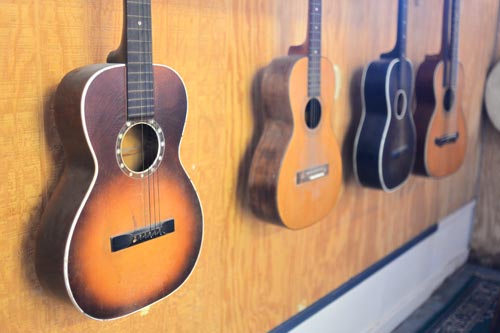

The 'value' of a vintage guitar is not a fixed number, perhaps it would be more convenient if it was, but there are numerous factors that come into play when trying to assign vintage guitars values. Where a guitar is sold, by whom, and to whom, all affect list prices. But on the whole, the biggest factor in determining vintage guitar prices is the rarity and collectability of the instrument. But then the price can vary hugely, depending on the guitar's condition. Both the Vintage Guitar magazine and Blue Book price guides suggest a three to five fold increase in value from a good (60%) condition guitar to a mint (100%) condition equivalent. This difference is lower in exceptionally rare models of course where even poor condition examples are considered collectable.
 photo Ronald Sarayudej
photo Ronald SarayudejCollectors care about condition. Not just whether a guitar works or whether it looks clean. If the original finish has been replaced, or the guitar has had repairs (which may not be apparent to the untrained eye, especially if you don't know where to look) or has any missing or exchanged parts or electronics (again not always obvious) the guitar goes down in value. Players, on the other hand are far less worried about such issues. Naturally a purely collectable guitar (i.e. one that does not function especially well as an instrument, or is too rare or fragile to use) will have a different kind of buyer than an old, but otherwise functional instrument bought to be played - perhaps a 1960s Gibson or Fender.
So when considering the importance of condition and originality on vintage guitar pricing, to some extent we need to consider whether the guitar is a collector rather than a player. One sad truth is that many SUPERB players instruments, are rapidly become collectors instruments, purely because of the prices attached to them. Pre-CBS Fenders are fantastic instruments to play, but generally people do not take guitars worth more than their car to be battered and knocked about at a gig.
The only really mint guitars available are the new old stock or NOS guitars out there. Ones that never sold first time round; usually complete with hang tags, warranty cards, case and outer shipping box. These guitars, when they come up, are priced way above the typical values of these guitars. Most likely sold to long-term vintage guitar investors with no interest in playing the instrument.
Guitars are meant to be played. And most have been, and most are still every bit as playable as the day they were made. There's nothing wrong with a well-loved guitar, fully functioning and all original, but with some minor play-wear; the small dings associated with general use. Weather checking maybe even adds a certain something. Replaced strings are expected, and a replaced nut or potentiometer is quite possible.
A seriously used guitar might have had a refret, or even replaced tuning keys. These are not too big a deal assuming no modifications were made. It is really important when performing repair work on such guitars, not to do anything that will irreversibly affect the guitar's value. New hardware can very often be fitted without any extra drilling, routing or other modification to the guitar, and any respectable luthier will always take this approach if at all possible.
But as the dings get greater in frequency and size, parts are lost, and maybe even a structural repair has been carried out, so the value decreases. But these guitars, especially if we are considering something with a small production run are still desirable, to players and collectors alike.
Some guitars of yesteryear are superb playing instruments, made from the fine, resonant pieces of tropical hardwood now impossible to get from the worlds rainforests. Whatever customisations or repairs have been done to these instruments over a long functional life - a refinish, the fitting of replaced components, extra pickup routes and so on - will not stop this guitar having a certain intrinsic value as a fine musical instrument. Except in the rarest cases, these guitars will be considered players grade instruments - i.e. not for collectors. They do offer, however, some of the best opportunities for serious musicians to play great old vintage guitars, that are firstly affordable, and secondly not too precious to take to a gig. With all other things equal, a headstock broken five times is no less valuable than a headstock broken just once.
Finally, some guitars are in such bad condition, poor sounding, badly made, and even a hindrance to play, that they will never even be worth attempting to use. These are no longer functioning musical instruments. Interestingly enough, even a guitar in this category, if rare enough, or historically interesting might still be collectable, even though nobody in their right mind would play it.
Title: The Guitar Player Repair Guide - 3rd edition
Price: $21.77
Author: Dan Erlewine
What we think: If you play guitar you should own this book. There is so much information - but most importantly the step by step instructions on performing a guitar set-up; setting action, intonation and correct stringing. Lots of simple jobs that anyone can do, but really make a difference to your playing.
Publishers notes: This expanded edition for beginners to experts is a step-by-step manual to maintaining and repairing electric and acoustic guitars and basses. Players learn how to set up a guitar and keep it in top form by mastering basic maintenance...
>> Click here to purchase from Amazon